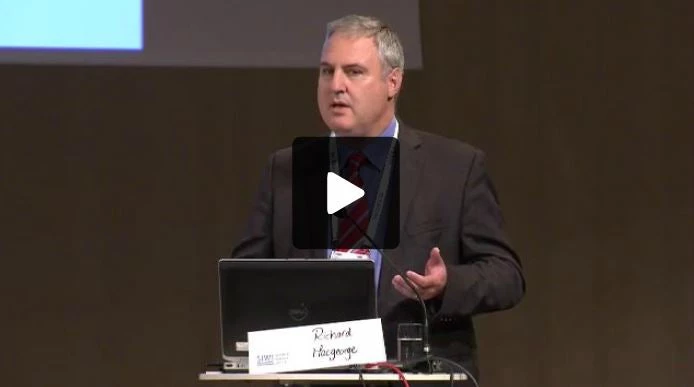
World Bank Group Lead Infrastructure Specialist,
Richard MacGeorge, presented on the challenges
of financing for development in the water sector.
It’s been 27 years since I have been to Sweden, backpacking my way around the country and marveling at its beautiful natural environment. So it was with real excitement that I set off for the SIWI World Water Week in Stockholm that ran between 23-28 August. I was especially keen to understand better the big issues that the world is facing, particularly since the theme this year was “Water for Development.”
My World Bank colleagues, and particularly those from the Water Global Practice, were well represented and participated in 13 of the events during the week, so the stage was set for serious discussion. As part of that discussion, I presented on the challenges of financing for development in the water sector. I wanted to leave the audience with three key messages. These were that (1) water is physically but not financially transparent; (2) financial innovation has to be conducted in parallel with and reflect the transitional nature of capital markets and (3) other sectors can give us guidance.
What commercial financiers want are financially sound organizations with good governance, delivering a service that customers value, and to which they can provide finance. In the water sector, one of the keys to this is finding a balance between concerns about affordability of water charges and recovery of reasonable costs, but it’s like a financial see-saw. Consumers want low prices whilst utilities need prices that will ensure they can cover the cost of finance. It sounds simple, but we know it’s not.
Getting the affordability-cost balance right will require water utilities to become increasingly efficient and commercially oriented (but this does not imply a change in public ownership necessarily). We also know that utility owners need to support commercial discipline through improved governance and ensuring competent managers are in place. This is tough when many owners are also responsible to local taxpayer-consumers, raising the case for independent regulation to help assess tariff levels and identify reasonable costs. It is not always possible to recover reasonable operating and capital costs through the tariff even with efficient finance. Subsidies to bridge the social-commercial (or viability) gap will continue to play an important role, but careful measurement and regulation is needed to make sure that subsidies are well targeted, have a clear objective, and do not establish perverse incentives.
This led the presentation to turn to the question of not waiting for reforms to be completed but developing financing approaches that can be implemented in parallel. In part this is because the pool of options changes as a capital market develops with the role of international financial institutions (IFIs) being important in nascent markets, with IFI support transitioning away over time as a track record is established.
As to the pool of financing options itself, we discussed the pool of options being broken down into revenue support (tariffs and subsidies), risk mitigation (hedging, guarantees and financial insurance), funding (preparation, micro-finance and aggregation models) and measurement (credit ratings and benchmarking). Benchmarking and ratings might seem like an odd part of the mix, but financiers don't like uncertainty and there is no amount of pricing that can compensate for poor performance.
All that can seem a bit abstract, so we looked at a real life case and peeked into what's happening in the energy sector at the same time. Learning from another sector to bring it all together is always helpful so we examined Kenya Power (KPLC) a little. In Kenya KLPC is the power utility and, like many utilities, is facing growth driven capital expenditure challenges financed with expensive and short term debt that can be alleviated with the careful use of credit enhancement instruments. So, the World Bank is working with the Ministry of energy and KPLC to help three things: (1) improve service delivery and reliability; (2) improve revenues and (3) support an electrification program. This is coupled with steps to reduce the cost of financing through a refinancing with a partial credit guarantee, all of which aim to steer the company toward improved financial stability.
In leaving the stage I felt that I’d left some messages that were important but reiterated the sad reality that the fundamentals of finance remain the same for the water sector as for any other sector and there is no financial “magic bullet.” However, improving the efficiency and financial performance of water utilities will open the door to financing options with longer maturities, lower spreads and better currency matching. Better still, more people will get improved services at a reasonable cost and that is a worthwhile endeavor.
Related link:
Livestream: Financing for Development: Innovative Financial Mechanisms for the Post-2015 Agenda


Join the Conversation